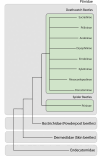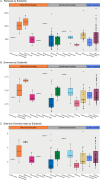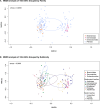The bacterial microbiome in spider beetles and deathwatch beetles
- PMID: 40207924
- PMCID: PMC12054154
- DOI: 10.1128/spectrum.01981-24
The bacterial microbiome in spider beetles and deathwatch beetles
Abstract
The beetle family Ptinidae contains a number of economically important pests, such as the cigarette beetle Lasioderma serricorne, the drugstore beetle Stegobium paniceum, and the diverse spider beetles. Many of these species are stored product pests, which target a diverse range of food sources, from dried tobacco to books made with organic materials. Despite the threat that the 2,200 species of Ptinidae beetles pose, fewer than 50 have been surveyed for microbial symbionts, and only a handful have been screened using contemporary genomic methods. In this study, we screen 116 individual specimens that cover most subfamilies of Ptinidae, with outgroup beetles from closely related families Dermestidae, Endecatomidae, and Bostrichidae. We used 16S ribosomal RNA gene amplicon data to characterize the bacterial microbiomes of these specimens. The majority of these species had never been screened for microbes. We found that, unlike in their sister family, Bostrichidae, that has two mutualistic bacteria seen in most species, there are no consistent bacterial members of ptinid microbiomes. For specimens which had Wolbachia infections, we did additional screening using multilocus sequence typing and showed that our populations have different strains of Wolbachia than noted in previous publications.
Importance: Ptinid beetles are both household pests of pantry goods and economic pests of dried goods warehouses and cultural archives, such as libraries and museums. Currently, the most common pest control measures for ptinid beetles are phosphine and/or heat treatments. Many ptinid beetles have been observed to have increasing resistance to phosphine, and heat treatments are not appropriate for many of the goods commonly infested by ptinids. Pest control techniques focused on symbiotic bacteria have been shown to significantly decrease populations and often have the beneficial side effect of being more specific than other pest control techniques. This survey provides foundational information about the bacteria associated with diverse ptinid species, which may be used for future control efforts.
Keywords: Anobiidae; Bostrichidae; Bostrichoidea; Dermestidae; Ptinidae; Sodalis; Wolbachia.
Conflict of interest statement
The authors declare no conflict of interest.
Figures





Similar articles
-
Adults of Lasioderma serricorne and Stegobium paniceum (Anobiidae: Coleoptera) Are Attracted to Ultraviolet (UV) Over Blue Light LEDs.J Econ Entomol. 2017 Aug 1;110(4):1911-1915. doi: 10.1093/jee/tox127. J Econ Entomol. 2017. PMID: 28498915
-
Insect Pests and Integrated Pest Management in Museums, Libraries and Historic Buildings.Insects. 2015 Jun 16;6(2):595-607. doi: 10.3390/insects6020595. Insects. 2015. PMID: 26463205 Free PMC article. Review.
-
The complete mitochondrial genome of the cigarette beetle, Lasioderma serricorne (Coleoptera: Anobiidae).Mitochondrial DNA B Resour. 2017 Jul 25;2(2):430-431. doi: 10.1080/23802359.2017.1357448. Mitochondrial DNA B Resour. 2017. PMID: 33473851 Free PMC article.
-
Rediscovering a Forgotten System of Symbiosis: Historical Perspective and Future Potential.Genes (Basel). 2020 Sep 9;11(9):1063. doi: 10.3390/genes11091063. Genes (Basel). 2020. PMID: 32916942 Free PMC article. Review.
-
New Coleoptera records from New Brunswick, Canada: Dermestidae, Endecatomidae, Bostrichidae, and Ptinidae.Zookeys. 2012;(179):127-39. doi: 10.3897/zookeys.179.2627. Epub 2012 Apr 4. Zookeys. 2012. PMID: 22539890 Free PMC article.
References
-
- Oliver KM, Smith AH, Russell JA. 2014. Defensive symbiosis in the real world – advancing ecological studies of heritable, protective bacteria in aphids and beyond. Funct Ecol 28:341–355. doi:10.1111/1365-2435.12133 - DOI
LinkOut - more resources
Full Text Sources

